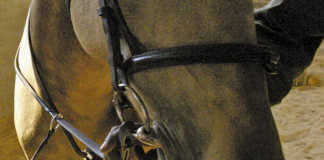
Derived from herbs, flowers, gums, fruits, seeds and roots, essential oils each possess unique qualities that heal various discomforts. If a horse is left in its own natural habitat, it will seek out the right plant or herb to alleviate whatever ails it. Essential oils are found in tiny pockets on the surface of plants. Through distillation, the oils are chemically changed to create a very concentrated and powerful remedy.
They are among the few substances that pass through the dermal layers and into the bloodstream. They also evaporate easily and can be breathed in.
A horse has a very well-developed sense of smell and knows how to smell essential oils correctly – first with one nostril, then, if it is ‘interested’, with both nostrils. If the aroma offers no therapeutic value, the horse will turn away.
I owned a horse that would do anything for peppermints. When offered a choice between a sweet treat and peppermint essential oil, it would choose the oil almost every time.
Your horse’s needs
To check which oil your horse requires, choose no more than five different oils at a time. Offer each to the horse (never let the bottle touch the nostril). Then note the horse’s response. If it’s interested it may:
- Smell the bottle with both nostrils flaring;
- Try to eat the bottle (be careful the horse does not get it out of your hands);
- Lack of interest will be signalled by smelling with just one nostril, then backing away from you.
A good essential oil comes from vetiver (Chrysopogon zizanioides), a tall grass native to India. It produces a network of roots and is sometimes planted to stabilise soil and prevent erosion. Cleaned, dried and distilled, these roots also produce a sweet, earthy-smelling oil. I have found it to be good for strengthening the skin and promoting blood flow. Always dilute it, though.
Applications
Essential oil can be applied in a variety of ways:
- When bathing your horse: Add five to 10 drops of essential oil/s to a bucket of warm water. If your horse’s skin is sensitive, first blend the essential oil in a teaspoon of carrier oil – almond is a good option. Alternatively, if your horse suffers from dry skin, dilute the oil/s in 50ml of almond oil before adding to the bucket of water. Sponge the horse for about 10 minutes.
- Massage: Add five to six drops of essential oil per 10ml of carrier oil. Mix thoroughly and apply liberally to the skin. Vetiver oil is excellent when massaged into the big muscle groups.
- Inhalation: Add four to five drops of essential oil to a bowl of steaming water. Place the mixture over a small amount of hay in a feed bag and hang the bag over the nose band of a halter. Let your horse inhale the vapour for a few minutes.
- Burners and diffusers: Fill the bowl of a burner or vaporiser with water and add three to six drops of essential oil. Light the candle. The oil will evaporate as the water heats up. Do not let the bowl dry out.
I keep several burners in a safe location in the stables to help repel mosquitoes and flies. Add citronella, cedar and lavender oil for this purpose.
Caring for essential oils
Essential oils and carrier oils are living products vulnerable to heat, moisture, air and light. It’s best to store them in a cool, dark place with the container lids well sealed. If your fridge is the only cool place around, allow the oils to reach a cool room temperature before use (around 20°C).













